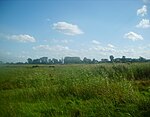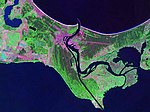Świnoujście LNG terminal

The Świnoujście LNG terminal (also referred as Terminal LNG in Świnoujście, Polskie LNG Baltic LNG, or gazoport) is a liquefied natural gas (LNG) import terminal at Świnoujście, in the extreme north-west of Poland near the Polish-German border. The LNG terminal is operated by Polskie LNG S.A., a subsidiary of Gaz-System. The cornerstone for construction was laid on 23 March 2011 and it took its first LNG delivery on 11 December 2015. The terminal's regasification capacity is 5 billion cubic metres per annum (180 billion cubic feet per annum). The terminal is currently being expanded and once the expansion is complete in 2023, it will have a capacity of 7.5 billion cubic metres per annum (260 billion cubic feet per annum) and be able to satisfy about half of Poland's annual natural gas demand. Together with the 10 bcm of natural gas that Poland will (starting in 2023) receive annually from Norway via the Baltic Pipe natural gas pipeline, the Świnoujście LNG terminal will allow Poland to achieve its long-term goal of becoming fully independent of Russian natural gas, which had previously been the source of almost all of the country's natural gas.
Excerpt from the Wikipedia article Świnoujście LNG terminal (License: CC BY-SA 3.0, Authors, Images).Świnoujście LNG terminal
Nowoartyleryjska, Świnoujście Chorzelin
Geographical coordinates (GPS) Address Nearby Places Show on map
Geographical coordinates (GPS)
| Latitude | Longitude |
|---|---|
| N 53.909166666667 ° | E 14.294722222222 ° |
Address
Wieża wydmuchów
Nowoartyleryjska
72-602 Świnoujście, Chorzelin
West Pomeranian Voivodeship, Poland
Open on Google Maps










